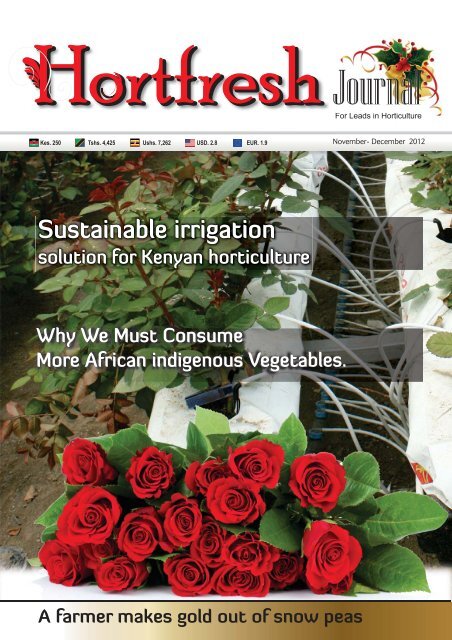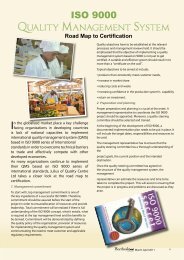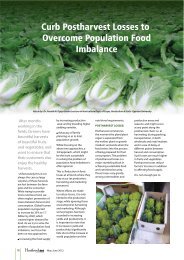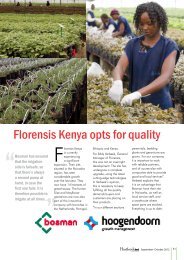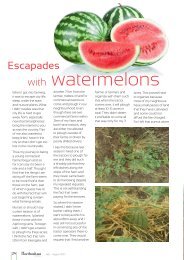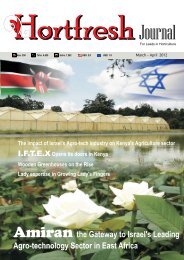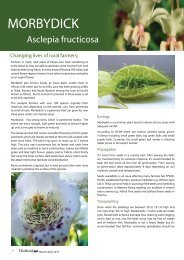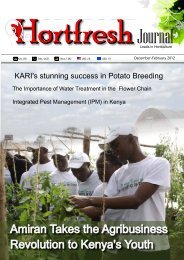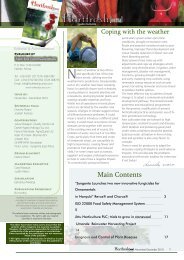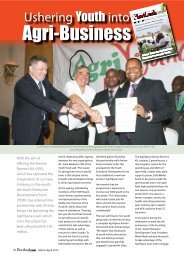Hortifresh Nov__December 2012.indd - Hortfresh Journal
Hortifresh Nov__December 2012.indd - Hortfresh Journal
Hortifresh Nov__December 2012.indd - Hortfresh Journal
- No tags were found...
Create successful ePaper yourself
Turn your PDF publications into a flip-book with our unique Google optimized e-Paper software.
1-3i
David Ruchiu, FCI Regional Director shares point with Koffi Annan during the visit to thecassava processing unit in MbuguniMbuguni Commercial Villagewhere Kofi Annan andMelinda Gates visited issituated in Mbuguni WardMeru district, Arusha regionTanzania. It is about 59kmfrom Arusha town. The majorfoods crops grown withinthe village include Cassava,Maize, Beans, Pigeon peas,Green beans, Cowpeas andSweet potatoes. The Cassavavariety grown is KigomaRed, predominantly resistantto Cassava Brown StreakDisease, Cassava MosaicVirus and Cassava green Mite.The variety has a maturityperiod of 6-8 months with aproduction capacity of 37-64MT per hectare. Village basedmultiplication of this varietyhas been done in partnershipwith Horti Tengeru Researchinstitute in Arusha.Mbuguni is one of sixCommercial Villagesimplementing the CassavaVillage Processing Programme(CVPP) with Farm ConcernInternational, with thesupport of the Alliance fora Green Revolution in Africa(AGRA). The project involves5,500 households and over30,000 beneficiaries.Africa’s Green Revolution will be led by smallholder farmers like Joyce MeenaJoyce Meena tends her cassavafarm in Mbuguni Commercial Village,Arusha TanzaniaJoyce Meena and herhusband Elia aresmallholder farmers inMbuguni CommercialVillage, Arusha Tanzaniawhich is also a FarmConcern International Sitefor the Cassava VillageProcessing Programme(CVPP) supported bythe Alliance for a GreenRevolution in Africa(AGRA). In the wordsof AGRA President, MrsJane Karuku, smallholderfarmers, most of whomare women, account forover 80 percent of Africa’sstaple food productionand hold the key tounlocking the continent’sagricultural potential.Feted by keynote speakersincluding Mr Kofi Annanand Melinda Gates at theAfrican Green RevolutionElia and Joyce plan, work and invest together on their farm.Forum 2012, in Arusharecently, Joyce and Elia farmmainly maize, banana andcassava on 1.5 acres offamily land for their ownconsumption and leasea further 11.5 acres ofland to grow cassava forcommercial purposes.Having invested in improveddrought and pest resistantseeds for maize, bananaand cassava, the couplereport that their incomeshave vastly improved whichenables them to supporttheir own three children andthree orphans, the childrenof Elias deceased brother.2For leads in Horticulture<strong>Nov</strong>ember- <strong>December</strong> 2012
The 10th NaivashaHorticultural Fairwas held on 14thto15th September2012. It was officially openedby agriculture minister HonDr. Sally Kosgei and KenyaCommercial Bank directorof mortgage business JoramKiarie. Other in attendanceincluded Horticultural CropDevelopment AuthorityDirector Dr. Alfred Serem,Kenya Plant HealthInspectorate Services,Dr. James Onsando,Fresh Produce ExportersAssociation of Kenya, C. E.O250 exhibitors,50 of which weremultinationals in theflower, vegetableand fruit industries.They included flowerbreeders, marketingfirms, transportationand logisticscompanies andservice providers.Dr. Stephen Mbithi, KenyaFlower Council, C.E.O MrsJane Ngige among others.When addressing journalist,Dr. Kosgei said that the fairhas become a ‘one-stopshop’; that brings togetherall industry stakeholders toshowcase their products andservices and discuss how tomove the sub-sector forward.“As a government, we havereceived complaints fromproducers on the slowpace of VAT refund and weare working closely withthe ministry of finance tostreamline the payments,”Sally said. Regarding thegovernment’s incentivesto enable farmers boostproduction, she said that thegovernments have removedtax on farm inputs such asfertilizers and pesticides toincrease access to farmersand also reduce productioncosts. She added that thegovernment is working closelywith large scale and smallscale horticulture producersto smoothen their operationsby removing obstacles. “Thehorticulture industry is inprivate hands and the onlything the government cando is to create an enablingbusiness environment forthe private sector to achievetheir targets,” she said.On behalf of KCB as a leadingfinancier of agribusiness inthe region, Mr. Kiarie said thebank has invested Ksh12m(US$140,000) in the fair forover the period. NaivashaFair has been sponsored bythe Kenya Commercial Bankfor the past three years.“The horticulture industrycontinues to contribute tothe Kenya economy throughthe generation of income,creation of employmentopportunities for rural peopleand foreign exchange earningsin addition to providingraw materials to the agroprocessing industry”, he said.On exhibitors side, AmiranKenya Ltd head of agrodivisionMr. Yariv Kedar saidthat the fair has providedthem with a platform toshow case their irrigation kitsand other farm technologiesfor smallholder to largescale horticulture farmers.The fair attracted more than250 exhibitors, 50 of whichwere multinationals in theflower, vegetable and fruitindustries. They includedflower breeders, marketingfirms, transportationand logistics companiesand service providers.Companies that showcasedinclude Crop NutritionLaboratories, BosmanEngineering, ChrysalAfrica, Orbit Chemical, JosHansen,Syngenta, BayerEast Africa, Greenlife, FPSAfrica ,Koppert, Everris, Elgon,Sametract among othersThe fair provided a goodopportunity to interactwith farmers, breedersand service providers.For leadsin Hortic<strong>Nov</strong>embmber-Decee mbeber220122in Horticulture3
Smallholder farmers feed over 1000delegates at AGRF on AfricanTraditional Foods DayTanzanian President,H.E. President Jakaya MrishoKikwete acquaints himself withFarm Concern International atthe AGRA Market Access standduring the AGRF 2012 in ArushaAs ordinary citizensand global leadersacknowledge the persistentdevelopment concerns ofhunger, malnutrition andclimate change, and theaccompanying challenges offeeding the African continent,the potential of Africantraditional foods to meetthese real challenges tendsto be down-played in theon-going debates for creatingsustainable and nutritiousfood sources to feed AfricaAbout the African Green RevolutionForum 2012, Arusha, Tanzania26 th -28 th September, 2012Farm Concern Internationalparticipated at the AfricanGreen Revolution Forum2012 in Arusha, Tanzania,joining key African andglobal leaders to answerto the question of how tofeed the future. The theme4For leads in Horticultureand theworld.However,Africantraditionalfoods arenot onlyhighlynutritiousbut alsowidelyavailable,diverse andperformwell undercultivationeven inextremeclimaticconditions.They also lend themselvesto a creative and diverserange of cuisines, tastes andopportunities for utilisation.The African GreenRevolution Forum, inArusha, Tanzania providedan opportune momentto raise the profile ofAfrican traditional foodsby showcasing this richdiversity and versatilityunder the theme of an‘African Traditional FoodsDay’ alongside the plannedconventional menu forover 1,000 guests at theNgurdoto Mountain Lodgewho included the Chair ofthe Alliance for a Greenof the Forum was ScalingInvestment and Innovationfor Sustainable AgriculturalGrowth and Food Security.Food security is high onthe global agenda, withleaders turning to Africafor agricultural solutions<strong>Nov</strong>ember- <strong>December</strong> 2012Revolution in Africa (AGRA),Kofi Annan and TanzanianPresident, Jakaya Kikwete .The venue was the NgurdotoMountain Lodge, Arushaand smallholder farmersfrom various parts ofArusha Region who arefacilitated by Farm ConcernInternational (FCI) withthe support of AGRA andthe Bill & Melinda GatesFoundation played a key rolein supplying the ingredientsthat went into making a richvariety of authentic Africanculinary experiences onthe lunch menu that day.The menu had threecategories of Africantraditional foods includingvegetables, energy foods,and protein sources. Thevegetables dishes servedwere; Ngogwe (Okra) ,Bamia (African egg plantsserved with okra), Matembele(sweet potato leaves) andMajani ya maboga (pumpkinleaves). Plant proteinserved included; Pigeonpeas (Mbaazi) with coconutmilk), Dolichos /blackbean(ngwara ). Among theenergy-giving foods, greenbanana, baked sweet potato,Ugali wa mihogo (cassavaflour ugali from cassavaflour), and maghimbi (arrowroots fried with carrotsthat will see 50 millionpeople raised out of povertyover the next decade.This calls for tangibleinvestments in Africa’spotential for rapid andsustainable agriculturalgrowth as well as raisingKofi Annan and Melinda Gatesengage with a nutritionist atMbuguni. Looking on are MumbiKimathi, Strategy & InnovationsDirector FCI (seated 2ndleft) and Ann Mbabu, Director,Market Access Program AGRAand onion) was served.Alongside the Africantraditional food the chefincluded a few other exoticfoods like fried Irish potatoesand vegetable rice as wellas a mouth-wateringvariety of animal protein.As they dined, the delegateswere able to keep up withthe latest information onAfrican traditional foods,including recipes via five TVscreens placed at vantagepoints throughout the diningareas. The delegates got acomplementary bookmarkalong with their lunch whichelicited positive responsesfrom the delegates withsome inquiring if they couldhave the recipes to try athome after the Forum.Pix available (Studio)Nutritious composite flours includingCassava and Sorghum fromMbuguni Commercial VillageMbugunithe capacity of millions ofsmallholder farmers to riseto the challenge of unlockingthe continent’s potential.
Why We Must ConsumeMore African indigenous Vegetables.Prof. Abukutsa at farmers field in Githunguri.“Let Food be yourMedicine & Medicinebe Your Food”. Socrates,the great philosopher oncesaid. Nature has providedus with a variety of fooditems that can be utilizedfor optimal nutrition andgood health, yet challengesfacing the world todayinclude malnutrition, lifestylerelated diseases and poverty.For instance Kenyans areconsuming only 31kg/person/year of vegetables which isbelow WHO recommended73kg/person/year. This hasresulted to an upsurge of dietrelated diseases like diabetes,cancer, cardio-vasculardisorders and obesity.Africa is endowed withagricultural biodiversity likeAfrican indigenous vegetablesthat have not been fullyexploited for nutrition, healthand sustainable development.African indigenous vegetablesare those vegetables whoseprimary or secondary centreof origin is believed to be inAfrica. They include vegetableslike African nightshade(mnavu, managu), vegetableamaranth (mchicha. terere),spiderplant (sageti, tsisaka),vegetable cowpea (kunde),jute mallow (mrenda), vineor African spinach (nderma),slenderleaf (mtoo) and Africankale (kanjira, kadhira).It was in view of thisthat Prof Abukutsa Maryinitiated multidisciplinaryand multi stakeholdersresearch Programme in1991 at JKUAT and 1996at Maseno University topromote the production andsustainable utilization ofAfrican indigenous vegetablesfor nutrition security andpoverty reduction in Kenyaand beyond. The programmestudy sites included Western(Kisumu, Siaya, Kisii, HomaBay, Kakamega, vihiga,Bungoma counties ), Central(Nyeri, Thika,Nairobi andKiambu counties) Kenya andparts of Rift valley (Kajiado,Nakuru, Kericho, Eldoret).The research programmeincluded baseline, household,institutional and marketsurveys; germplasm collection,evaluation, selection, seedmultiplication, quality testing,bulking, packaging anddistribution; physiological,agronomic, nutritional, valueaddition and recipe andproduct development studiesand conservation efforts.Funding between 1992 and2012 by various fundingagencies including JKUAT,African Highlands initiative,SIDA-Sarec through IPGRI,& VicRes, EU and NCST hasbeen in the tune of 90 millionKenya Shillings. Currently theprogramme is undertakingstudies on African nightshade,Spiderplant and vegetableamaranths funded by NCSTand slenderleaf funded byRPE (JKUAT) with several BSc,MSc and Ph.D students.Some of the findings andresults have indicated thatAfrican indigenous vegetableshave competitive advantageover some of the conventionalwell known global vegetables.African indigenous vegetableshave high micronutrientcontents, for example Jutemallow (mrenda) containstwenty times more ironthan cabbage and fivetimes more than spinach.These vegetables have highcontents of anti-oxidants,these phyto-chemicalsscavenge for radicals in thebody and make our bodiesless predisposed to dietrelated diseases like diabetesand cancer. Generally AIVshave several other health<strong>Nov</strong>ember - <strong>December</strong> 2012For leads in Horticulture5
enefits in particular extractsfrom bitter gourd fruits, anindigenous fruit vegetablehave been found to bebeneficial to diabetics as theycontain insulin and Africannightshade and slenderleafhave been implicated intreatment of stomachrelated ailments like duodenalulcers. Besides AIVs are welladapted to local climaticconditions, seed productionis possible in the tropics,they have a short growthperiod and flourish undersustainable cropping systemsand are stress tolerant.Despite the advantages,optimal production andsustainable utilization hasnot been realized due to thefollowing constraints: negativemindset and attitudes bystakeholders; inadequateknowledge sharing;inadequate quality seed andtechnical information forfarmers and consumers; andpoor marketing channels.However, several strategieshave been employed in theprogramme to repositionAfrican indigenous vegetableslocally, continentally andglobally and these include:• Identification AIVs on theAfrican continent withnutrition, health benefitand economic potential• Advocacy and Promotionat the local, nationaland global level• Involvement ofstakeholders from themedia, farmers, students,policy makers, otherresearchers from KARIand Universities, NGOsand private sector andProf Abukutsa’s AIVs seed bulking at JKUAT farmusing participatory, valuechain approach in theresearch programme.• Development ofdiversified disseminationmaterials fordifferent levels• Development ofseed supply system(community andresearch level)• Capacity building atall levels (farmers,students, researchers,policy makers)Research Programme whichwas initiated in 1991 at JKUATand is ongoing today hasover 300 contact farmers inWestern and Central Kenya,several under graduate andpostgraduate students. Someof the tangible outputs andoutcomes include: availabilityof reference materials(papers, theses and technicalreports, books and bookchapters), quality seed,dissemination leaflets, goodcrop for farmers, availabilityof the vegetables in supermarkets, recipes and products,increased, production,popularity and consumptionleading to improved healthand income generation. Thiswork has received nationalcontinental and internationalrecognition and accoladesby the African Union, CTA,RUFORUM and KenyanPresidential award in 2009and 2010 to mention but afew. Local and internationalmedia also has greatlypublicized and promoted theProf. Abukutsa with student at Maseno University6For leads in Horticulture<strong>Nov</strong>ember- <strong>December</strong> 2012
PARTINGSHOT“African IndigenousVegetable are HighProfile Commoditieswith Nutritional andUnrivalled HealthBenefits, they havea great Potential toContribute to the FoodBasket to Feed the Worldin the 21st Century”.Welcome Aboard and BePart of this CrusadeSeed processing on farmers field in Siaya districtIK processed products in Siaya districtProf Abukutsa with students at JKUATAIVs due to the results andoutputs obtained from theprogramme. Following mediacoverage of Prof Abukutsa’sAIVs project by the standardon 27 th March 2012, 80participants of StrategicLeadership DevelopmentProgramme (SLDP 52) at KIAof which Prof Abukutsa wasone visited JKUAT On 26 th ofApril 2012 to witness theprogrammes, innovationsand technologies at theuniversity. These seniorgovernment officials visitedthe tissue culture, theengineering workshop andthe AIVs project and wereextremely impressed by thestrides being made by JKUATAfrican indigenous vegetablepotential as an export cropis high and currently valueaddition studies are underwayso that these vegetables canbe exported to Europe andUSA where consumers inthe diaspora have expressedinterest in these vegetables.More research is neededand promotion to ensureoptimal utilization of AfricanIndigenous Vegetables.Prof Abukutsa MaryO.O., Professor ofHorticulure: Departmentof Horticulture, JKUATE-mail: mabukutsa@yahoo.comor Abukutsa.mary@gmail.com<strong>Nov</strong>ember - <strong>December</strong> 2012For leads in Horticulture7
Technical SupportAnytime , AnywhereChrysal Africa'sTechnical Consultants are available year- round to support all Chrysal customers intheir post-harvest processes.The team has extensive combined experience in post-harvest processes, flower growing, soiland water analysis,water management and an excellent understanding of what it takes to be agrower in the region.Travelling around East Africa to growers and bouquet makers,the team provides: Private, personalised audits with progress tracking, On farm and off farm training,Experience support,Support for trials and R&D, Backup for trials and testing in Nairobi and Holland, Post-harvest water use management, Links to buyers and processors in Europe, the Americas, Australia and the Far East. Chrysal Africa's confidential audits cover post-harvest solution quality, hygiene, temperatureand humidity, packaging and handling.Audit reports score each section according to the performance at the audit using a traffic light system,and provide a progress tracker so growers can track how well they are performing.Chrysal Africa's technical team is intergrated with that of Chrysal International to bring you the mostup to date technical innovations and information from Australia and Japan through Europe to the Americas.EXAMPLE AUDIT TRACKERLAST AUDIT% THIS AUDIT% PROGRESS709052907565 662030229POSTHARVEST HYGIENE TEMPERATURE OVERALL-25Trials and tests can be undertaken in Chrysal Africa and Chrysal International in Holland;Further follow ups can be requested in each of the locations mentioned above.For any technical queries, support and information, the Chrysal Africa technical teamis available to visit your farm, check your processes,recommend improvements, provide internationalbackup networks and lend a hand when and where you need it the most.Contact us at: info@chrysal.co.ke, steve.mbogo@chrysal.co.ke,anniemarie.dolier@chrysal.co.ke
Chrysal Africa now offers-:pre-treatment chrysal RVBClear intensive 1 mI/LGeneral Post- harvest product for Roses Chrysanthemumand a wide range of summer flowers Does not contain Aluminium sulphate, therefore less risk of leaf scorchingand leaf drop- enabling a longer storage period in the solution. Available in 10L and 100 l sizesEffects Stimulates water uptake, thus preventing“ bent-neck” in Roses. Prolongs vase life of flowers. Lowers the pH of the water Maintains the quality of flowers. Dissolves clearly and without odour in water.Applications Suitable for all types of water, For soft waterwe recommend RVB clear Soft Water Intensive. Can be dosed automatically. For use by growers and flower importersSavings Reduced flower wastage.Prolonged distribution and sales period possible.Reduced water consumption and labour costs,as the solution can be re-used.RVB Clear IntensiveContact us now locally, in Kenya. We’ll give you the support you need.Premises No. 7, Sunflag compound, off Mombasa Road & JKIA Resort Slip Road,P.O Box 78219 00507 Nairobi, KenyaTel: +254715046799,E-mail: info@chrysa.co.ke. www.chrysal.com
used: rain water, drainwater, water from thelake and water borehole.The Hoogendoorn processcomputer determines exactlythe best choice, which leadsto greater convergence ofcosts and results. Throughcharts and graphs thegrower can continuouslyfollow the situation in hisgreenhouse and wateringis precisely done on theplants need. The easy to usesoftware allows employeesat Van den Berg Roses toget the most out of thecrop, allowing good qualityroses to be produced.Purpose ofthe projectThe aim of this project is tocultivation is essential forgood water management.Moreover, optimizing irrigationlevel based on the needs ofthe crop throughfor examplemeasuring drain water enablescrop to grow vigorously.Coco substratesFor the Green FarmingWater Management project,coconuts substrates areprovided by Van der KnaapGroup. The big advantageof coco mats is that theyare very homogeneous,especially compared toloose-filled substratesand open fields. Thishomogeneity ensures a stableair rate and thus a muchcontrollable substrate. Thehomogeneity of the substratesave 40-60% of irrigationwater while achieving a 10%increase in yields. In orderto provide food securityand quality, water-efficienttechnologies are required.This enables horticulturegreenhouses and farmsto use clean water anduse it as economical aspossible, without wastingit. As a result of therecirculation of drainedwater, water is saved ina sustainable manner.Collected rain water andsurface waterneed to becleaned before being used asirrigation. However, boreholewater is in essential clean.The possibility to re-usecollected drain water in soilbased as well as in substrateresults in a homogeneousand uniform crop.Coco mats ensure goodrooting and initial growthof rose plants. As cocomats can be re-used as asoil improver, it is a verysustainable substrate.Project at Vanden Berg RosesThe demonstration of theproject takes place at Vanden Berg Roses company inNaivasha, Kenya. Van denBerg Roses is one of theupper end Kenyan rosesexporters with a more thanten rose-variety.In cooperationwith the KenyanJomo Kenyatta University ofAgriculture and technology,Wageningen UR will bemonitoring the project andpresenting the results.<strong>Nov</strong>ember - <strong>December</strong> 2012For leads in Horticulture11
A farmer makes gold out of snow peasGold is scarce;though it is in everyplace; few find itand it always the godaring. At the edgeof Kereita forestnear Kimende, in aplace fondly calledCarbacid meetMr. John NjorogeMwaniki who isgrowing snow peaswith dissimilarity. Inthis place renownfor sukuma wikigrowing, he hasbeaten all odds andventured into snowpeas growing andhe is smiling all theway to the bank.Since 2006 John startedgrowing snow peas and hasnot turned back but hasincreased his acreage tothe current 8 hectares. Hehas won various awards,for instance Global G.A.P ashe has conformed to goodgrowing practices, world foodday 2011, 2012 and to thearea he is a mentor. Farmingto him is a business whichshould bring in returns; itis not for pleasure and thishas made him be dedicated,investing in it fully. Withfarming he has earned somemillions and this gives himpassion to do it all the more.Asked why he decided toventure into snow peasgrowing unlike the norm ofthe area. John said snow peasfarming is expensive andrequire a lot of experiencethat’s why many people inthe area shun it. On theother hand, him he sawit is an opportunity sinceit is an export crop; thedemand is high and thereis always a ready market.Passion and commitmenthas brought him this far.To take advantage of thedry season John constructeda dam which he has sinceadded other two, he wouldpump water with a Listerdiesel pump but has now14For leads in Horticulture<strong>Nov</strong>ember- <strong>December</strong> 2012
upgraded to electricity pump.His farm is networked withdrip systems and overheadsprinklers. He is alsoconnected to a second sourceof water that is from Kiriitaforest which he collects into atank and is channeled to drips.Mr. Njoroge’s MahunguFarm is divided into variousblocks which have snowpeas in different stages.This has made it possiblefor him to supply all yearround. A kilo of snow peasis going for kshs.120 andin a year he sells severaltonnes. This has enabled himto expand and has boughtand leased several shambasin the neighborhood whichhe has planted snow peas.The process of growingsnow peas starts with firstpreparation of the groundby digging and applying ofcompost mature. Holes aredug on the ground at leastone inch, single seeds aredropped into each hole andcovered with top soil. Snowpeas require a large amountof water during growththus watering after everypicking is recommendedto improve quality.They are supported usingbamboo and strings. Stringshould be tied to the baseof the plants and then tothe wire above it. As theplants grow another stringis tied 10 cm above theprevious one to ensure theplant grows through loops.Snow peas major diseasesduriringgrorowth includepowdery mildews manifestingas white powder, leaf spots,downy mildews and rust. Tocontrol John uses certifiedseeds from syngenta, AmiranKenya and sprays withrecommended fungicideswhich he says syngentais the main supplier.He practices crop rotationand use of resistant ortolerant varieties. Majorpests to snow peas includethrips, aphids, bollworms,red spider mites’ bean flyand nematodes. Controlis by using recommendedinsecticides. Heavy rains arealso a challenge especiallyto germinating snow peas.Harvesting of snow peasstarts after 8 weeks aftersowing and continues for1-2 months. Young tendereponds are harvested befoforethey become fibrous.Ponds are twisteted fromtheplants leaving a short stalk.Snow peas are ordinarilypicked thrice a week andfive times a week duringwarm and hot weather tokeep the vines bearing.Post harvest handling ofsnow peas includes placingthe produce in plasticcontainers and covering withmoist clean cloths preferablywhite in colour to maintainlow temperatures. Sortingis done to remove diseased,damaged ponds and overgrown one before packing.Dirty ponds should be washedin clean water to remove soiland dried with a soft cloth.High standards of hygieneshould be maintained duringgrowth and handling.Apart from Snow peas Johnhas planted cabbages, beans,baby corns, potatoes buthe uses this to crop rotateand as wind breakers.15
Post Harvest LossesAn Everyday Challenge for Cut RosesPostharvest managementplays a critical rolein enhancing thecompetitiveness of cutflowerswhich by nature are highlyperishable. Roses grown inopen fields and greenhousesby small ,medium and largescale farmers for exportare of particular interestnot only because it is oneof the major cutflowersgrown in the country butalso because of its fairquality and perishability.The radom appraisals,market visits, and qualityprofiling shows technicaland nontechnical problemsthat constrain the industry.Postharvest problems includeovermaturity of flowersat harvest, mechanicaldamage, absence or nonimplementationof customerspecific standards, shortvase life and poor qualityof sold flowers and lack ofawareness on proper handling.Other problems includelack of capital, high cost ofpackaging and transport,lack of postharvest facilitiesand high losses duringthe low demand period.The plant physiology behindcool chain management;RespirationHarvested cut roses arealive, which means thatthey will constantly respire.Respiration involves thebreakdown of carbohydrate(example sugars) and otherfood reserves (organic andfatty acids) in the plant orin harvested produce andresults in the production ofcarbon dioxide, water andheat. Respiration occursboth pre- and post-harvest.C6H12O6 + 6 O2 6 CO2+ 6H2O + Heat (2830 kJ)Respiration will occur inpresence or absence ofOxygen .The more rapid therespiration rate, the fasterthe flower will consume itsfood reserves, the greaterwill be the heat producedand the shorter will be thepost-harvest life of the flower.Growth and developmentThe respiration will produceenergy necessary for thedevelopment of floral partsand thus opening of theflower will continue evenafter the harvesting.Physiological breakdown;The cells may disintegratewith exposure to toolow temperatures.Pathological breakdown;This involves the activityof bacteria and fungi. Theymainly occur on injuredplant surfaces .The endresult is decomposition.Temperature managementTemperature management,commonly referred to as thecool chain management issingle most important factorthat affects cut roses.Temperature has a linearcorrelation with post harvestplant processes of growthand development-(Floweropening ) ,Physiologicalbreakdown and pathologicalbreakdown-decomposition/botrytis .Furthermore,exposure to high temperaturein the display area and failureto rehydrate or conditionthe flowers results in wiltingand eventually drying ofblooms. Temperature has asignificant influence on therespiration rate of harvested<strong>Nov</strong>ember - <strong>December</strong> 2012For leads in Horticulture17
Application of ModifiedAtmosphere Packaging forFresh Fruits & Vegetables.Article by Dr. Arnold M. Opiyo Senior Lecturer in HorticultureDept. of Crops, Horticulture & Soils - Egerton UniversityFruits and vegetables areliving, respiring and perishableproducts with activemetabolism even after harvestfrom the parent plant. Nearlyall products are packaged atsome point in their life cycle.When packaging vegetablesand fruits the gas atmosphereof package is not air (O 2– 21%; CO 2 – 0.01%; N 2 –78%) but consists usually ofa lowered level of O 2 and aheightened level of CO 2 . Thiskind of package slows downthe normal respiration of theproduct and so prolongs theshelf life of the product.The key to keeping thesepackaged products freshfor a long duration is toreduce the respiration ratewithout harming the qualityof the product (its taste,texture and appearance). Ingeneral, respiration rate canbe reducucedby keeping thetemperature low, having lowerconcentrations of oxygen inthe packaging atmosphereand increased levels of carbondioxide. However, excessivelyhigh levels of carbon dioxidecan damage some varietiesof products. The storagelife and quality of fruits andvegetables can be extendedby modifying the atmospheresurrounding products. Amodified atmosphere canbe defined as one thattis created by altering thenormal composition of air(21% oxygen and 0.03%carbon dioxide) to providean optimum atmospherefor increasing the storagelength and quality of produce.Modified atmospheres can beachieved by using modifiedatmosphere packaging (MAP).Supermarkets often look forways to package food to helpit stay fresher for longer onthe shelf. New technologysuch as modified atmospherepackaging can provide moreoptions, but it can alsoprovide an environmentfor pathogens to gro w!MODIFIED ATMOSPHEREPACKAGING:Plastic films are widely usedin packaging, and continueto grow in use as more andmore applications switchto flexible packages suchas modified atmospherepackaging (MAP). In thesepackages, plastic films may beused alone or in combinationsto serve the basic packagingfunctions of containment,protection, communicationand utility in the deliveryof quality products tothe consumer. Modifiedatmosphere packaging(MAP) is a packagingtechnique used to extendthe shelf life of fresh food.The types of food storedthis way include vegetables,salad greens, pasta, meat,fruit, cheese, seafood andbakery products, such assandwi cheses. It (MAP) is an<strong>Nov</strong>ember- <strong>December</strong> 201219For rleleadsin Horticulture
inexpensive way of delayingfruit ripening; where fruitsare sealed in semi-permeableplastic packages that enablethe development of abeneficial gas atmospherecreated and maintainedby the interaction of fruitrespiration and gas diffusionthrough the packaging film.MAP, when combined withproper postharvest handlingprocedures and temperaturecontrol management, canhave a positive impact onthe quality and shelf life offresh produce. MAP is onlyeffective if there is consistenttemperature managementthroughout the entiredistribution channel. Theability of MAP to extend theshelf life of foods has beenrecognized for many years.MAP may be defined as thepackaging of a perishableproduct in an atmosphere,which has been modifiedso that its composition isother than that of air.Modified atmospheres maybe produced naturally byrespiration (Passive MA)and by the application ofgas flushing techniquesMAP techniques involveeither actively or passivelycontrolling or modifying theatmosphere surrounding theproduct within a packagemade of various types offilms. Active modificationoccurs by the displacementofgases in the package, whichare then replaced by a desiredmixture of gases,whilepassive modificationion occurswhen the product is packagedusing a selected film type,and a desired atmospheredevelops naturally as aconsequence of the products’respiration and the diffusionof gases through the film.A sliced or grated vegetableis still alive and it continuesto respire - it creates amodified atmosphere withinthe pack with a reduced levelof oxygen and an increasedlevel of carbon dioxide.For respiring produce, thepermeability characteristicsof the film determine to alarge degree, the equilibriumgas concentration achievedin the package. The actualequilibrium MA attained withina package will also depend onfactors such as the preparedform of the vegetable,the rate of respiration atstorage temperature, thepack volume and fillweight,and the surfaceareas for gas exchange.Fiigure 1Figure 1 Modified Atmosphere PackagingPotentialAdvantages &Disadvantagesof MAPAdvantages:• Potential shelf lifeincreases of 50 to 400%• Reduced economic loss• Products can bedistributed overlonger distances andwith fewer deliveries,leading to decreaseddistribution costs• Provides a highquality productDisadvantages:• Visible added cost• Temperature controlnecessary• Different gas formulationsfor each product type• Special equipment andtraining required• Product safety tobe establishedPACKAGETYPES:Many types of plastic filmsare available for packaging,but relatively few have beenused to wrap fresh produce.Polyethylene is the mostcommonly used polymer filmfor packaging. Its advantagesare being inert, permeableto gases and impermeableto water vapor. The conceptof using polymeric filmsthat will allow development,and/or maintenance ofatmospheres other thanair, dates from the firstavailability of plastics. Lowdensitypolyethylene, polyvinylchloride, and polypropyleneare the main films used topackage fruit and vegetables.Polystyrene has been used,but polyvinylidene andpolyester have such lowgas permeability that theywould be suitable only forcommodities with very lowrespiration rates. However,perforating these filmscan expand their use tomany commodities. Theplastic film used in MAP islow-density polyethylene20For leads in Horticulture<strong>Nov</strong>ember- <strong>December</strong> 2012
(LDPE), linear low-densitypolyethylene (LLDPE), highdensitypolyethylene (HDPE),polypropylene (PP), polyvinylchloride (PVC), polyester, i.e.polyethylene terephthalate(PET), polyvinylidene chloride(PVDC), polyamide (Nylon)and other suitable films.Many factors influencefilm permeability, amongwhich polymer type and filmthickness are most important.Due to differences in therespiration rates of individualfruits or vegetables, the typeof plastic film required toachieve any special equilibriumMA must be defined for eachcommodity. The transmissionof CO 2 and O 2 throughplastic films will vary withfilm types, but generallyfilms are 4 to 6 times morepermeable to CO 2 than to O 2 .Perforations - Punchingholes in the plastic canmaintain high humidity aroundthe produce, but it may beless effective in delaying fruitripening because it does nothave the same effect onthe CO 2 and O 2 contents ofthe atmospheres inside thebag. The holes may be verysmall and in these casesthey are commonly referredto as micro-perforations.Figure 2Current applicationsof MAP technology forfresh and minimallyprocessed productsWith commodity-generatedor passive MA, if productand film permeabilitycharacteristics are properlymatched, the desiredMA can passively evolvewithin a sealed packagethrough consumption ofO 2 and production of CO 2by respiration. The gaspermeability of the selectedfilm must allow O 2 to enterthe package at a rate offsetby the consumption of O 2by the commodity. Similarly,CO 2 must be vented fromthe package to offset theproduction of CO 2 by thecommodity. Furthermore,the desired MA must beestablished within 1 to 2dayswithout creating anoxicconditions or injuriously highlevels of CO 2 that may inducefermentative metabolism.Recent advances in thetechnology of manufacturingpolymeric films havepermitted tailoring films forspecific gas diffusion needsof some fruit, vegetables, andtheir products. MAP is mostcommonly used for freshcut (minimally process ed)fruit and vegetables andfor highly perishable, highvalue commodities, suchas strawberry (Fragariaananassa Duch.).Benefits of film packaging,other than creation ofMA conditions can includemaintenance of high relativehumidity and reductionof water loss; improvedsanitation by reducingcontamination of theproducts during handling;minimized surface abrasionsby avoiding contact betweenthe commodity and thematerial of the shippingcontainer; reduced spreadof decay from one produceitem to another; facilitationof brand identification andproviding relevant informationto the consumers. In manycases the benefits of usingMAP relate more to one ormore of these positive effectsthan to the changes in O 2 andCO 2 concentrations withinthe package. In contrast,the negative effects includeslowing down cooling ofthe packaged productsand increased potential forwater condensation withinthe package, which mayencourage fungal growth.Figure 3CONCLUSION:The rapid growth of MAPproducts in the marketplaceindicates that the benefitsof the system to theretailer, manufacturer, andconsumer clearly outweighthe disadvantages.Food safety must continue tobe of prime concern of MAPfood. The effective and safeuse of MAP requires effectivecontrol of temperature.Poor temperature controleliminates the beneficialeffects of any MAP systemand may cause health hazards.Figure 2 Micro-perforated ModifiedAtmosphere PackageFigure 3. Water condensation in MAP<strong>Nov</strong>ember - <strong>December</strong> 2012For leads in Horticulture21
Seaweed Biostimulant For Vegetative Development
What is OptimizerSeaweed Liquid biofertilizer produced from Ascophyllium nodosum seaweed extract base,enriched with chelating microelements for use in vegetables, flowers, coffee, cereals, potatoesand fruit trees as mangoes, avocados and grapes. It is designed to help the plant to overcomestress moments produced by drought, flooding, adverse weather etc. Its application perceptiblyincreases production as well as the plant general conditionWhat it containsDeclared contents:Ascophyllium nodosum seaweed extract, Nitrogen (Ureic Nitrogen, Organic Nitrogen),Water-soluble potassium and Phosphorous, EDTA chelated Copper, Zinc, Molybdenum andBoron, Water-soluble amino acids and alginic acidOptimizer is a bio-stimulant based on high quality seaweed extract of Ascophylliumnodosum, plus chelated nutrients. Optimizer Seaweed stimulates beneficial soil microbialactivity, resulting in a substantially larger root mass thus enabling the plant to draw nutrientsand moisture in times of stress resulting in overall stronger root structure may help plantsphysically resist certain types of root diseases.It has:tionand give fruits and vegetables a naturally longer shelf life..plant to stay green for longer time. It also promotes the growth of fruits and reduces prematuredropping of fruit.inducing faster and vigorous root development;What it doesincreasing the cationic exchange capacity and the soil flora.crop.in cell elongation and give fruits and vegetables a naturally longer shelf life.Read More >>>>>
Agronomist corner with Joseph Ole Muli – joseph@greenlife.co.keVARIETIESPod shapes, waxed pods, ovaletc differentiate the cultivarsgrown. The most popularvarieties for export are:• Amy beans: - These aremainly extra fine beans.Their pod ranges 0.5mm– 0.8mm or less andlength being 5 – 6cm.• Paulista beans: - Theseare mainly fine beans.Their pod diameter rangesfrom 0.5mm – 0.8mm,the length of the podsbeing 7cm – 9cm.• Samantha beans: - Thisvariety is both forextra fine as well asfine beans. This is theintermediate betweenthe above two varieties.• Other varieties includeCoby, Monel, Julia, Claudia,Gloria, Maasai, Morgan,Fanado and Espada.ECOLOGICAL REQUIREMENTSAgro-ecological zonesThe best areas for productionof French beans fall withinthe lower highland tolower midland zones.AltitudeOptimum altitude is between1000m to 2000m above sealevel; however, the beans maygrow satisfactorily outsidethese limits. In warmerareas, they mature faster.TemperatureThe optimum temperature forbeans ranges between 16°C– 24°C (minimum 10oc andmaximum 30°c) below 10°Cplants are destroyed by frost.It takes 4- 5 days for Frenchbeans togerminate at 16°C –24°C and takes 9days in cold days.RainfallHumid areas with regularrainfall and a limited dryseason are not suitable forthe production of Frenchbeans. Heavy rainfall affectsflower fertilization. Theoptimal rainfall should be 900– 1500mm, which should bewell distributed throughoutthe year. However, most ofthe French beans productionis done under irrigation.A moderate well-distributedrainfall is required (300-400mm per crop cycle) but dryweather during harvest isessential. Drought or waterloggings are detrimental.SoilsBeans can grow on a widevariety of soils but bestgrowth is obtained in welldrainedloams high in organic24For leads in Horticulture<strong>Nov</strong>ember- <strong>December</strong> 2012
matter. The best pH level forbeans is 6.5 – 7.5. Suitablesoil types range from lightto moderately heavy and topeaty soils with near-neutralpH and good drainage. Frenchbean is susceptible to salinity.EcologyFrench bean is a quantitativeshort-day plant. For everygenotype, there is anoptimum for photoperiodand temperature where thatgenotype will flower after thesmallest possible time intervalfrom emergence. Deviationsin either temperature orphotoperiod cause delaysin flowering. Most Frenchbeans are grown within anarrow range of temperatures(17.5-) 20-22.5(-25)°C;in the equatorial tropics,they are found at higheraltitudes (above 1000 m).Temperatures below or abovethe optimum reduce yieldthrough plant mortality (athigh temperatures), reducedphotosynthesis and failure offlowers to produce maturepods (50-70% of openedflowers). French beans aresensitive to night frost.Suitable growing areasThey include Nairobi, Kiambu,Murang’a, Kirinyaga, Mbere,Meru, and Naivasha.USESFrench bean is used as a pulseand as a green vegetable. Theyoung pods and ripe seedsare eaten and, to a lesserextent, also the green-shelledseeds. In some parts of thetropics, young leaves areused as spinach. In temperateregions, French bean isgrown mainly for the greenimmature pods that are eatenas a vegetable, and are alsocanned and frozen. The driedseeds are also cooked withtomato sauce and canned.Preparation is by boiling;beans are very acceptablewith a wide range of meatand vegetable sauces. Thestraw can be used as forage.AGRONOMIC ASPECTSPropagationand PlantingNormal propagation is by seedbut for special purposes stemcuttings can be rooted easily.Plant population densitiesare 150,000 -200,000plants/ha for dwarf cultivarsand half that for climbingtypes in sole cropping. Inintercropping, densities aremuch lower. Plant distancevaries for bush cultivars insole cropping 30-45 cmbetween the rows and 30 cmin the rows. Wider spacingto 75-90 x 10-15 cm makesweeding easier. For climbingbeans, 4-6 seeds are usuallysown together in hills spaced1 m apart. They may also besown in rows at a spacing of90-120 x 15-30 cm. Depth ofsowing is 3-6 cm. Seed ratedepends on seed size andintended plant populationdensities, up to 120 kg/ha fordwarf beans and 60 kg/hafor climbers in sole cropping.HusbandryFlat cultivation is preferredto ridges. Disturbance ofthe soil should be avoidedbecause damage to the rootsor the collar of the plantencourages diseases. Soshallow tillage is preferredespecially in the period beforeflowering. French bean canbe rain-fed or irrigated.Irrigation is beneficial in semiaridregions, with overheadirrigation preferred overflood irrigation. In peasantfarming, the crop is seldommanured. Crop rotation isnecessary to limit disease.HarvestingSnap beans are harvestedbefore the pods are fullygrown.Harvest starts 6-8weeks after sowing in early cultivars. Pods should be pickedevery 3-4 days, and the number of pickings is greater in climbingcultivars than in bushy ones. The pods are carefully picked andnot pulled from the plants and must have a stalk attached tothem. After picking the pod s are taken to the grading shedimmediately to avoid deterioration of quality. Harvesting duringwet conditions is not recommended, but if unavoidable, the podsshould be placed in a clean cloth to dry them before packing.Handling after HarvestHigh standards of cleanliness should be maintained in handlingharvested French beans. The harvested pods should beplaced in clean plastic containers and covered with a cleandamp cloth to avoid shriveling. The pod is then sorted outto remove broken, malformed, overgrown, off types andinsect-damaged pods. The pods are then taken for packaging,pre-cooling and transported In carefully stacked cartons.Pests and Diseases1. Rust (Uromycesappendiculatus)Disease development favoured by highhumidity. Recognized by the presenceof slightly raised, small, white spotson the lower leaf surface which turnsred to dark brown after a few days.Control: Spray with copper based fungicidesevery 2 weeks at flowering at 50g/20Lt wateror Katerina 720SL at 40ml/20Lt/Ha.2. Angular Leaf Spot (Phaeoisariopsis griseola)Characterized by necrotic and well definedlesions with a typical angular shape. Lesionsmay increase in size, coalesce and cause partialnecrosis and yellowing of leaves, which may<strong>Nov</strong>ember - <strong>December</strong> 2012For leads in Horticulture25
fall prematurely. On primaryleaves, lesions are usuallyrounded, larger than thosefound on trifoliate leaves andmay develop concentric rings.Control: spray with Katerina720SL at 40ml/20Lt/Ha.3. Root Rots(Fusarium spp,Phythium spp,Sclerotium spp etc)Affectedplants showyellowingand dryingof stem at soil level.Stunting may occur. Seedlingestablishment is poor,uneven growth, chlorosisand premature defoliationof severely infected plants.ControlDrenching with Tower72% WP at 50gm/20Lt4. Bacterial Blights(Pseudomonasphaseoli)Spreadthroughsplashingfromexudinglesions and plant debris.Affected plants show haloson the leaves, drying ofleaf margins, yellowingand water soaked pods.ControlSpray using Cadilac 80%WP at 50g/20Lt5.Anthracnose(Colletotrichumlindemuthianum)Fungus seedborne andaffects all aerialplant parts.Spread by rainsplash, windor mechanical contact andoccurs in cool, damp weather.Disease characterized bythe appearance of sunken,26For leads in Horticulturebrown spots with blackedges on pods, whileothers on leaves. There areangular brown spots andoblong stripes on stems.ControlUse of certified seeds or foliarspray using Tower 72%WPat 50g/20Lt or Katerina 720SL at 40ml/20Lt or Cadilac80% WP at 40g/20LtInsects / Mites1.Root KnotNematodes(Meloidogyne spp)Attack roots causing lesions,root gallsor swellings,plantstuntingandwilting ofseverely infected plants. Thelesions also serve as entrypoints for bacteria and fungi.Affected plants are dwarfedand have distorted leaves.ControlCrop rotation with nonsusceptiblecrops such asmaize and grasses. Youcould spray nematicides.Soil applied foliar fertilizers<strong>Nov</strong>ember- <strong>December</strong> 2012increase root biomassand favor growth anddevelopment of antagonisticpathogens. Apply PlantGuard Fertilizer to increaseroot biomass at secondweek of germination.2.Bean Fly(Ophiomyia spp)The adultis a small2 wingedinsect whichcan be seenresting on the leaves whereit lays the eggs. The damageis caused by the larvae whichmine the stem. The larvaealso feed on the cotyledonsof seedlings before theyemerge. Affected plants areyellow, stunted and stemsare cracked at the soil level.ControlEscort 19EC sprays atgermination up to 1sttri-foliage stage at 2 weekintervals. Kingcode 5%EC to be applied fromflowering stage and throughthe harvesting periodat weekly intervals. Soiltreatment with Exempoat 20 Ml/100L at 7 dayintervals is also appropriate.3.Bean thrips(Megalothrips spp)Damage iscaused bythe nymphsand adultswhich feed and punctureflower structuresControlBefore flowering, foliarspray using Presento200SP starting from 2leaf stage, during flowering,apply Kingcode 5% EC4.Aphids (aphis fabae)They clusteron stems,leaves andbean pods.They suck plant sap andcause the plants to stunt.Control:Spray with Presento200SP early stagesand during floweringuse Kingcode 5% EC5.Red Spider MitesMain damage is on theleaves which turn silvery andbrownish in colour. Infectedleaves have cobwebs onthe lower leave surface.ControlSpray with Escort 19EC.6.Cut WormsAre active at night andhide during the day. Theycut stems of young plantsabove or below soil level andalso feed on plant foliage.ControlSoil treatment with Spectator48% EC at 150ml/100L at 7day intervals at germinationup to primary leaves stage.7.CaterpillarsApply foliarspray withKingcode 5%EC or Spectator 48% EC
VALTRAPower PartnerVALTRACTCassini & Tonolo LtdMakasembo RoadP.O. Box 936 – 40100KisumuTel: 057-2024438Mobile: 0736-600909 / 0727-695120Email: info@valtract.comwww.valtra.com.br
Introduces Seed portfolio in itsproducts capElgon Kenya Ltd hasadded yet another featherin its products cap withthe introduction of aseed department.In a country where farmingactivities are increasing andalso being embraced ascommercial undertakings,lack of good certifiedseeds has always beena major challenge.With this in mind ElgonKenya has risen to theoccasion to help farmers’access high quality seeds.The company can nowconfirm the availabilityof a wide variety of OPs(open pollinated) and someextremely good performinghybrids of various vegetabletypes including carrots,cabbages, coriander,tomatoes, sweet pepper andwatermelon among others.Elgon Kenya Seeds ManagerMr. Manish Tyagi is assuringthat all company’s productsare genetically pure and goeson selling after trials inthe different climatic areaswhere its Agronomist arebased to conduct seed trialsand guide farmers on thebest seed and crop growingtechniques and skills.Elgon Kenya sources anddevelops the seeds fromvery reliable research basedcompanies all over the world.Hybrids strong edgeover Ops: Mr. Manishexpounded the facts;Generally Hybrid seeds havealways had an edge overOP variety seeds owing tohybrids wider adaptability,better disease tolerance andhigh yields in shorter times.CUCUMBER- ELGONCH 09- This hybrid is welltested in different weatherconditions of Kenya andhas been found suitable forboth open and tunnel (GreenHouse) planting. It’s a uniquehybrid that can performwell under high temperaturevariations from 10 degreesto 40 degrees centigrade.The hybrid is semideterminatetype a quickyielder, starts flowering inaround 35 days, fruiting in 45days and yielding in 60-65days: it continues to give highyield for next 75-80 days.Fruit color is dark green,tender rind, sweet in taste andsuitable to local market andexport also. Average (avg.),Fruit length is 18-20cm withavg. fruit wt. of 250 Gms.Elgon Cucumber CH 09 ishighly tolerant to some ofthe major crop diseases suchas Anthracnose, Powderyand Downy Mildew.Preferred Growing conditionfor Cucumbers is warmweather and minimumsunlight requirement is 7-8hrs, suitable soil temp. is70 degrees Fahrenheit andsoil ph should be 6.5. It isbetter to shield the cropfrom frost conditions.ELGON CH 09 growsin spacing of row to row of3-4 ft. and plant to plant at1-2 ft. This means per acreplant could be more and upto 9000 plants that willadd yield by 20% or more.WATER MELON– After vigorous testing,the company has come upwith two synchronized highyielder hybrids in sugarbaby segment that aretotal resistant to majorproblem of Fusarium Wilt.1. BLACKBALL F1– Thishigh yielding hybrid is darkgreen in color with avg. fruitwt. around 6-8 kg. Goodshelf life and sweet in taste.Avg. 2 fruits per plant. Itmatures in 90 days. Showsvery synchronized harvestingof total yield in 2 pickingsresulting in less labour cost.<strong>Nov</strong>ember - <strong>December</strong> 2012For leads in Horticulture29
2. SWEET FINEF1- This hybrid fruit isblack in color and of veryquick and high yieldingcharacter; average fruitweight is 6-8 kg. Maturityperiod is 100 days and verysynchronized maturity.To grow watermelons, soiltemperatures should bebetween 18-24 degreescentigrade and soil PH notmore than 6.8. It is alwaysbetter to grow watermelonsin ridges with row to rowdistance of 2m and plantto plant 30 cms. Oncethe vines are 2m long,pinch the tip to get morebranches and higher yields.CAPSICUM- GREENBELL F1- This new Elgoncapsicum hybrid is a vigorousyielder that suits well in greenhouse. Fruiting starts after35 days of transplantingtherefore efficient nutritionmanagement is required asthe hybrid is vigorous andearly bearer. This is planttype with good toleranceto all major diseases. Fruitweight is around 110 gmsand well suited to greenand Red fruit segment.Warm weather conditionsfor over a 5 months growingperiod are best for capsicum,optimum temperature forfruit setting is between 16and 21 degrees centigrade,for good fruit developmentnight temperature shouldbe between 15-17 while daytemperature should record24-30 degrees centigrade.Green Bell F1 is best amongthe hybrids in Kenya andfruits are well suited forsupermarket and local market.EGG PLANT- 1.BLACKBEAUTY (KANHIYA F1)-Large fruit Black beautytype around 250gms, Earlyfruiting in 45 days aftertransplanting , uniform darkblack color fruits tolerance todisease and pest particularlyJassids and performs well inall weather even winter also.2. ELGON LONG 732F1- Medium long fruitswith blackish purple colour,green calyx with averagelength of 12 cms and weightof 60- 70 gms. Profuseyields for longer duration.Besides these productsI would like to mentionexcellent upcoming hybridin Bombay, Red segmentnamed as RED SUPER F1is having clear cut edgein terms of uniform sizebulb, earliness and yield.Farmers are advised to usethese products and reapthe benefits in farming. Inthe future, we shall alwaysendeavor to give best servicesand products to our Farmers.Article by Manish Tyagi30For leads in Horticulture<strong>Nov</strong>ember- <strong>December</strong> 2012
Cabbage is an importantvegetable grown in Kenyafor the local fresh marketand little is exported also.It is grown under rain fedand irrigated condition. Cropwill tolerate a wide range ofenvironment conditions butthrives in cooler temperatures.100 gm of cabbages leafcontains 40 mg calcium, 0.5mg iron, and 30 internationalunits of vitamin, a potency,0.05mg riboflavin, and 0.3mg nicotinamide and 40mgascorbic acid. Cabbageismainly used for cookingand as salads. It is alsodehydrated and can also beused as a livestock feed.Cabbages can be dividedinto three main groups:Ball head (or roundhead),Conical (or sugarloaf) andthe large drumhead types.In Kenya cabbagevarieties grown dependon the targeted marketrequirement and taste. Thevarieties are classified as:(a) Processing – Large heads,firm, white varieties e.g.Big globe F1, Malkia F1.(b) Urban centers – Mediumto small heads e.g. ElgonCopenhagen, Greenglobe F1, Malkia F1(c) Rural areas – Mediumto large heads e.g.Elgon Copenhagen, Bigglobe F1, Malkia F1.(d) Kitchen gardensCopenhagen market –Varirietetieies withlonong harvrvestperi od e .g. Big globe F1,Elgon Copenhagagen.Elgon Kenya ltd is focusingvery much on developingand marketing of Cabbagehybrids for Kenya andafter large scale trading indifferent major markets likeKiambu, Karatina, Muranga,Nakuru, Eldoret, Athiriver,Nyahururu, Naivasha andNarok etc. We came upwith some excellent hybridsnamed as Big Globe F1, GreenGlobe F1 and Malkia F1.To grow any crop goodagricultural practice (GAP)is very important andplays major role in earningthrough farming. In cabbagethis process starts fromnursery management.(1) Need to have separateseed bed and field toreduce danger of carryover pests and diseaseso as to develop cleanplanting material fortransplantation.(2) Avoid to transplantthe seedlings showswilting symptoms,unhealthy green andwith black spots onstems and leaves.<strong>Nov</strong>ember - <strong>December</strong> 2012 31
(3) Be careful on spacingthat could vary as persegment and hybridcharacter, better toprefer to have closerspacing for (45-50 cm)for LxL (plant to plant)and larger spacing for RxR(60-75cm) so to keepoptimum plant populationaround 15-18000 plants/acre for best yield.(4) Timely irrigation andfertigation playsimportant role to get bestyield fertilizer dose tocabbage should be givenas follows: - Always bestto add 7-8 tons/acreof FYM then schedulechemical fertilizer/acreas follows: Basal Dose-DAP- 40kg + CAN- 40kg+ MgSO4- 10kg, 25days after transplanting– DAP – 20kg + CAN –20kg, 45-50days aftertransplanting- DAP- 20kg+ CAN – 20kg, You canalso use some foliarapplications of seaweedextracts like zyme etc toincrease curd weight.5) For highest yield cut thecabbages heads whenthey are solid and mature,sudden heavy rains maycause heads to cracks butto avoid such situationuse hybrids like BigGlobe, Green Globe andMalkia F1 of Elgon whosefield holding capacityis more than 15 days.6) Black rot is major diseaseand can be identified bylarge V shaped yellow tobrown areas in leaf andveins turn black. Timelysprays of Cupravit plusdeconil (kavach) willcontrol its spreading whilegrowing good tolerantvarieties like Big Globe,Green Globe and Malkiahybrids can be preferred.7) Major pest is DiamondBack moth (DBM) andtimely spray of coragenhelps in controllingthe pest well.Varietal selection plays majorrole in getting good harvestand Elgon Kenya presentsthree different hybridswith unique charactersto benefit the farmers.BIG GLOBE F1 – Compact,flat round large head plantup to 6kgs of Head wt.Leaves are bluish green andwaxy coated resulting inbetter tolerance to diseasesand pest. Harvestingstarts in 75 days and forbest head wt spacing of45*60 is recommended.GREEN GLOBE F1-Round head plant type; quickmaturing gaining weight upto 4kgs in 65 days aftertransplanting. Very uniquelong stem resulting in bettertolerance to high rains aswell as drought like situation.Best recommended toharvest during rainy seasonto fetch best profit andprice with very less damageto head. Best yield onsuitable spacing of 45x45.MALKIA F1- It’s a newupcoming hybrid showsexcellent performance intrials all over East Africa andsuitably competes amongthe large selling hybrids.Very compact head, 70days maturity attaininghead weight up to 6 kg.East Gate, Off MombasaRoad, P.O. Box 4682600100, Nairobi, Kenya.Tel: (020) 6534410Fax: (020) 6534807. E-mail:info@elgonkenya.comWebsite: www.elgonkenya.com32For leads in Horticulture
PREMPT 20 ECBroad spectrumInsecticidePrempt 20 EC isa broad spectruminsecticide containingjuvrnoid Priproxyfenand apyrethroid“Fenpropathrin” forcontrolling ofwhiteflies and othercomplex pest such ascaterpillars, thrips,leaf miners,aphids flowerbeetles, mealy andbudwormsGUARANTEE:East Gate Road, Off Mombasa East Gate Road, Road, P.O. Off BoxMombasa 46826 -Road00100, Nairobi, Kenya.Tel: (020) 6534410P.O.Fax:Box(020)468266534807.- 00100,E-mail:Nairobi,info@elgonkenya.comKenya.Tel: (020) 6534410Website:Fax: (020)www.elgonkenya.com6534807. E-mail: info@elgonkenya.comWebsite: www.elgonkenya.com
Local support formodern greenhouse solutionswater savings | energy savings | climate controlEngineeringFlower Business ParkP.O. box 1820 Naivasha+254 707000308+31 (0)10 4608080www.hoogendoorn.nl


